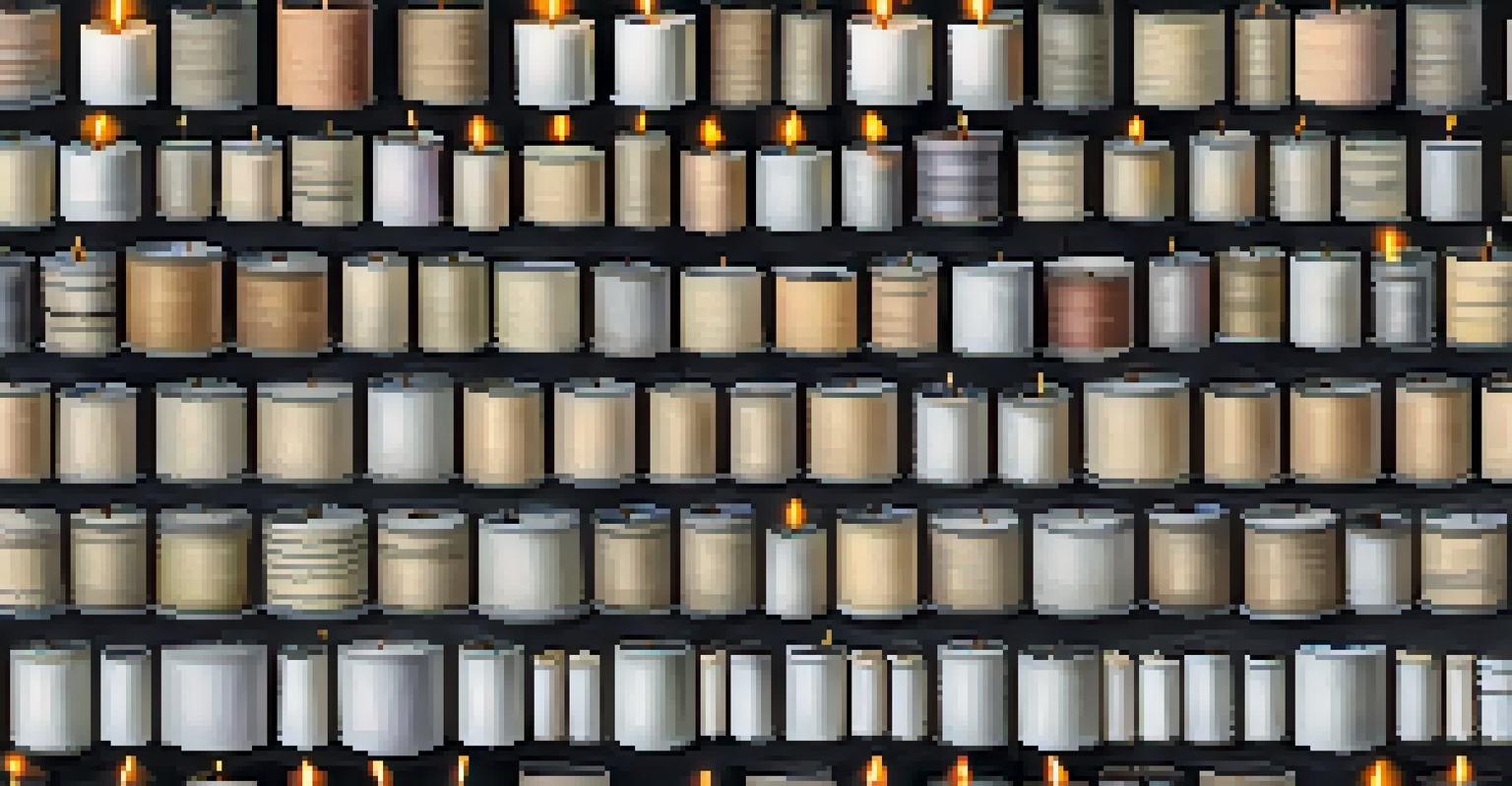Choosing the Right Wick Size for Your Candle Creations

Understanding Wick Size and Its Importance
Choosing the right wick size is crucial for the performance of your candle. A wick that is too small may not create enough heat to melt the wax properly, while one that is too large can lead to excessive soot and an uneven burn. The wick size directly influences the size of the flame, the burn time, and how evenly the wax melts.
A candle loses nothing by lighting another candle.
Think of your wick as the engine of your candle—if it’s not the right fit, your candle won’t perform at its best. The wick size determines how much fragrance and essential oils are released into the air, affecting the overall ambiance. So, understanding this fundamental aspect is key to crafting a successful candle.
In essence, the right wick size helps ensure a clean burn, optimal fragrance throw, and a beautiful appearance. With so many wick options available, it’s worth taking the time to find the perfect match for your specific candle formulation.
Factors Influencing Wick Size Selection
Several factors come into play when selecting the right wick size, including the type of wax you’re using, the diameter of your candle, and the additives in your formulation. For instance, softer waxes like soy may require different wick sizes compared to harder paraffin wax. Knowing the properties of your wax will guide your selection process.

The diameter of your candle is also a significant factor. A wider candle generally requires a larger wick to achieve a proper melt pool, while a thinner candle may need a smaller wick. This is similar to how a larger pot needs a bigger flame to heat water efficiently—the same principle applies to candle wicks.
Wick Size Affects Candle Performance
Choosing the right wick size is essential for achieving a clean burn, optimal fragrance throw, and even wax melting.
Lastly, consider any additives you’re using, such as fragrance oils or dyes. Some additives can affect how the wax burns, requiring adjustments in wick size. By taking these factors into account, you can make a more informed decision about your wick choice.
Testing Wick Sizes: The Trial and Error Approach
When it comes to selecting the right wick, testing different sizes is often necessary. This trial and error method allows you to see firsthand how each wick performs with your specific wax blend. You might discover that a wick that works perfectly for one type of wax doesn’t yield the same results for another.
The candle is a symbol of hope, light, and warmth, and it requires a perfect wick to shine bright.
Start by creating small test batches with varying wick sizes. Observe how each wick affects the burn time, flame height, and soot production. Keeping a detailed log of your observations can be incredibly helpful as you refine your candle-making process.
Remember, even small adjustments can have a big impact. What may seem like a minor change in wick size can significantly alter the candle’s overall performance. So, don’t hesitate to experiment until you find the perfect fit.
Common Wick Sizes and Their Applications
Wicks come in various sizes, typically measured by their diameter. Common sizes range from 1/4 inch to 1 inch, with different types designed for different applications. For instance, a 44-24-18 wick is often recommended for 8 oz. jars, while a 60-44-18 wick may be better suited for larger candles.
Understanding these common sizes helps you make quicker decisions in your candle-making journey. Additionally, many wick manufacturers provide guidelines that detail which wick size works best with specific wax types and candle diameters. This can serve as a great starting point for your experiments.
Testing is Key to Perfect Wicks
Experimenting with different wick sizes through trial and error will help you find the ideal match for your specific candle formulation.
As you gain experience, you’ll develop an intuition for which wick sizes work best with your unique blends. This knowledge can significantly streamline your candle production process and enhance your final product.
The Role of Wick Material in Size Selection
Wick material is another important consideration when choosing your wick size. Wicks can be made from various materials such as cotton, wood, or even bamboo, each affecting the burn characteristics of the candle. For example, wooden wicks often produce a unique crackling sound and may require a different wick size than traditional cotton wicks.
Different materials also respond differently to heat and wax type, which can further influence your wick choice. Cotton wicks are versatile and widely used, making them a go-to option for beginners, while wooden wicks are a trendy choice for those looking to create a rustic aesthetic.
When considering wick material, think about the overall experience you want to deliver. The right material paired with the right size can elevate your candle-making creations to new heights.
Understanding Burn Rate and Its Relation to Wick Size
Burn rate refers to how quickly a wick consumes the wax, which is directly tied to its size. A larger wick generally has a faster burn rate, leading to a shorter candle life, while a smaller wick burns more slowly, extending the candle’s lifespan. Understanding this relationship can help you create candles that match your customers' preferences.
For instance, if you’re making candles for a special occasion, you might want a larger wick for a brighter flame and quicker melt pool. On the other hand, if you're aiming for a long-lasting candle for everyday use, a smaller wick would be the better choice.
Wick Material Influences Selection
The type of wick material, such as cotton or wood, impacts the burn characteristics and overall experience of the candle.
Balancing burn rate and wick size is essential for creating the ideal candle experience. With practice, you'll be able to predict how different wick sizes will affect the burn rate and overall performance of your candles.
Final Tips for Choosing the Perfect Wick Size
As you embark on your candle-making journey, remember a few final tips to ensure you choose the right wick size. Always start with recommended guidelines and adjust based on your unique formulation and testing results. Keeping a consistent testing schedule will help you refine your approach.
Additionally, don’t be afraid to seek feedback from fellow candle makers or your customers. Their insights can provide valuable guidance as you navigate the wick selection process. Networking within the candle-making community often leads to discovering new techniques and tips.

Finally, enjoy the process! Candle making is a blend of science and art, and experimenting with wick sizes can lead to exciting discoveries. Embrace the learning curve, and soon you'll create candles that not only look beautiful but also burn beautifully.